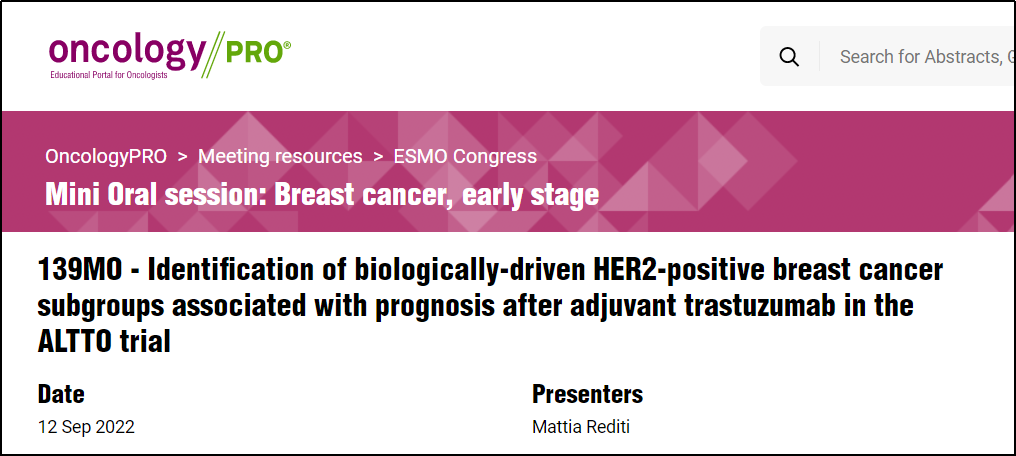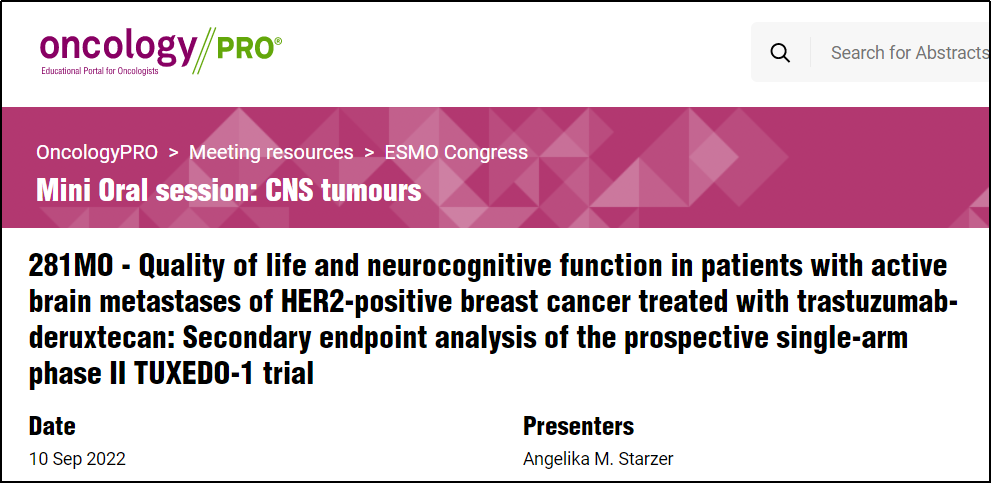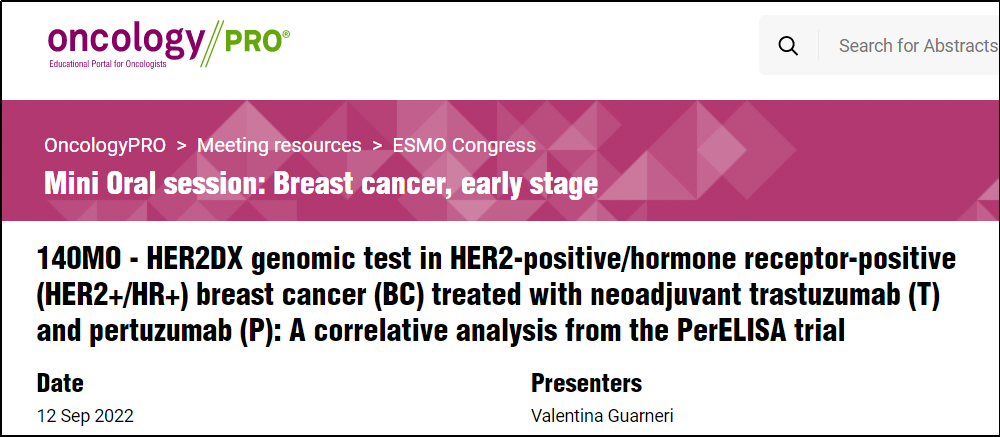New progress of HER2+breast cancer and brain metastases can change the clinical pattern?| 2022 ESMO
Author:Cancer Channel of the Medical Time:2022.09.15
*For medical professionals for reading reference

2022 ESMO Conference -new progress of Her2+breast cancer treatment plan
HER2 -positive breast cancer accounts for about 15%to 20%of breast malignant tumors, and has the characteristics of strong invasion, high recurrence rate, poor prognosis, etc. [1]. How to formulate a better treatment plan to significantly reduce the recurrence rate of such patients and extend the survival of HER2 -positive patients.
In 2022, the European Cancer Internal Science Association (ESMO Conference) was successfully held in Paris from September 9th to September 13th. The conference reported a number of heavy cutting -edge results about breast cancer. The three important studies, the main points of the report are as follows:
Refine the classification of breast cancer, explore the candidate plan for personalized therapy
确ALTTO: Determine HER2 -positive breast cancer subcontraction related to the prognosis of the auxiliary Tuskuzumab
Summary number: 139Mo

figure 1
The ALTTO TRIAL in the report is a forward -looking, random, open label, and multi -centered phase III clinical trial. This study is mainly to determine the Asian group related to patients who received the prognosis of patients in the phase III ALTTO test. feature.
■ Research method:
The method of using cases (1: 2) Choose 134 patients who transfer recurrence from the Quchuzumab group and 268 patients who have no distant transfer recurrence in the study;
Calculate the PAM50 subtypes with an absolute inner molecular type (AIMS), and use the Cox regression model and Kaplan-Meier's survival curve for long-term uncompromising survival status (DRFS) analysis.
■ Result:
Compared with the entire Twozumab group, the tumor size in the case control group is> 2cm, the proportion of patients with positive lymph nodes and G3 tumors is higher;
Select the gene related to DRFS for NMF analysis to obtain 4 factors; the K-average cluster determines 4 groups with different prognosis, namely the immune enrichment group (n = 69; 91%, 5 years of DRFS), metabolic wealth Collection group (n = 87; 51%, 5 years of DRFS), matrix enrichment group (n = 76; 58%, 5 years of DRFS) and hormone receptor positive group (n = 154; 78%5 years of DRFS) Among them, hormone receptor-positive enrichment groups are divided into HER2-E (n = 91; 72%, 5 years of DRFS) and non-HER2-E tumors (mainly luminal A/B) (n = 63; 87%, 5, 5, 5, 5, 5, 5, 5, 5, 5, 5, 5, 5, 5, 5, 5 DRFS).
■ Conclusion:
Through a method of monitoring from top to bottom, four biological -driven clusters are found in HER2 -positive breast cancer, which can be integrated with PAM50. The research results support the evaluation method in the Luminal group and immune enrichment sub -groups, and in the high -risk population, the single -risk population shows a good prognosis. But the conclusion still needs to be further verified.
T-DXD is used to treat active brain metastasis endless potential
疗T-DXD Treatment HER2-positive breast cancer with active brain metastases of patients' life and neurop awareness: A forward-looking, single-arm, II phase TUXEDO-1 test second point analysis
Summary number: 281MO

figure 2
As high as 15%of metastatic breast cancer patients will eventually develop into brain metastases in their respective course, of which the metastasis rate of three -negative breast cancer and HER2 -positive breast cancer [3]. Patients with brain metastases are usually accompanied by the decline in neural cognitive function, which further leads to a decline in quality of life.
Maintaining the quality of life (QOL) and neural cognition is a major goal of HER2 -positive breast cancer with brain metastasis (BM). TUXEDO-1 research explores the effects of T-DXD's QOL and neuropiacators on HER2-positive breast cancer with BM patients during treatment.
■ Research method:
Tuxedo-1 adult HER2-positive breast cancer patients who do not need to be treated with local treatment immediately are administered every 3 weeks until the disease progresses and unacceptable adverse adverse adverse adequate doses of T-DXD. Response or the patient's request to withdraw;
The secondary end of the test is QOL. Patients need to complete the EORTC QLQ-C30 questionnaire each time every 9 weeks and the following 9 weeks. The final assessment is conducted in the first survival follow-up of the three months after the treatment.
■ Result:
A total of 15 patients were incorporated, and all patients received at least one dose of T-DXD treatment;
During T-DXD treatment, the global QOL of QLQ-C30 (the slope of each follow-up is -0.13, P = 0.953), the body (0.52, P = 0.363), emotion (-0.24, P = 0.835), and cognitive functions Scores (-0.79, P = 0.429) remain unchanged.
■ Conclusion:
TUXEDO-1 shows that during the T-DXD treatment in patients with HER2-positive breast cancer BM, QOL and neural cognitive functions were maintained. The test data supports the first-line system treatment of T-DXD for active BM patients.
HER2DX may become a prediction tool for the prognosis of HER2+breast cancer
Analysis of 试Perelisa test: Her2 -positive/hormone receptor (HER2+/HR+) breast cancer patient HER2DX genome test summary number of HER2 positive/hro+hormone receptor (HER2+/HR+) of Tushuzumab and Puffyzumuke. 140Mo
image 3

In the early HER2 positive breast cancer, the upgrade or downgrade of systemic treatment has always been a controversial topic. HER2DX combines clinical data (such as tumor size and lymph nodes) and immune response, tumor division, tumor cell proliferation, and HER2 17Q12-21 biological information (including ERBB2 gene) of the expression of chromosome amplification subclaseer to help identify clinical clinical clinical do not need to do (New) Low -risk patients with assisted chemotherapy [2].
The PERELISA test in the newspaper evaluates the ability of HER2DX prediction HER2+/HR+breast cancer, and the effectiveness of new assisted treatment schemes of chemotherapy (CT).
■ Research method:
Her2+/HR+breast cancer patients with newly diagnosed the postmenopausal diagnosis will conduct HER2DX evaluation of the FFPE tumor sample before treatment; first receive 2 weeks of incezole (L) treatment, and then biopsy again to evaluate KI67; endocrine therapy sensitive tumor patients ( EST) (that is, the relative reduction of Ki67 in the second week of Ki67 continued to receive L and started T+P treatment of 5 cycles;
HER2DX provides 3 kinds of information, namely Her2DX recurrence risk scores, Her2DX PCR scores, and Her2DX ERBB2 scores to predict the ability of EST patients to completely alleviate (PCR).
■ Result:
Eventually included 40 patients with EST and conducted HER2DX evaluation. The PCR rate of EST patients is 22.5%. The Her2DX PCR score of this group is positively correlated with the probability of EST patients (P = 0.012; AUC = 0.80), and the PCR rate of low, medium, and high HER2DX PCR rating group is 8.0%, respectively. (2/25), 43.0%(6/14) and 100.0%(1/1);
Her2dx ERBB2 scores are positively correlated with the probability of obtaining PCR patients in EST patients (P = 0.004; AUC = 0.88), and independent of HER2 level (2+vs 3+), low, medium, and high HER2DX Erbb2 rating group's PCR rate is 0.0, respectively. %(0/12), 8.3%(1/12) and 50.0%(8/16).
■ Conclusion:
HER2DX can predict the early HER2+/HR+breast cancer patients with neo -assisted treatment of endocrine sensitivity and PCR after T+P+L. In this case, HER2DX can help adjust the whole body treatment plan.
The treatment of HER2 -positive breast cancer is still challenging. How to optimize the treatment of drugs and personalized treatment in the future will become the focus of clinical attention. A number of studies are in progress, and it is expected to bring more benefits to the treatment of HER2 -positive breast cancer patients.
references:
[1] Nader-Marta G, Martins-Branco D, de azambuja e.how we treat patients with metastatic her2-positive breaker.esmo open.2022 feb; 7 (1): 100343. 100343. 100343. 100343. 100343.
[2]Prat A,Guarneri V,ParéL,et al.A multivariable prognostic score to guide systemic therapy in early-stage HER2-positive breast cancer:a retrospective study with an external evaluation.Lancet Oncol.2020 Nov;21(11) : 1455-1464.
[3] Sanna, G.et Al.Brain Metastases in Patients with Advanced Breast Cancer.anticancer Res.27,2865–2869 (2007).
not
The first release of this article: the medical world tumor channel
Author of this article: SXH
Editor in charge: Sweet
- END -
Shandong Disease Control and Prevention Recent Epidemic Prevention and Control Public Health Tips (updated on August 30)

Epidemic preventionPrevention and control of recent epidemicPublic Jiankang Remind...
The Personal Disease Capital Platform establishes a transparent operation committee to strengthen the management and control of "malicious promotion"

Cover news reporter Zhang YuexiAlthough the emergence of a large -scale fundraisin...